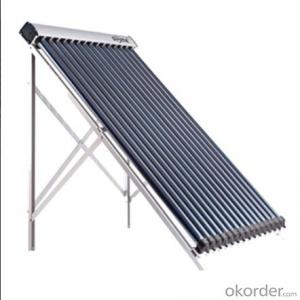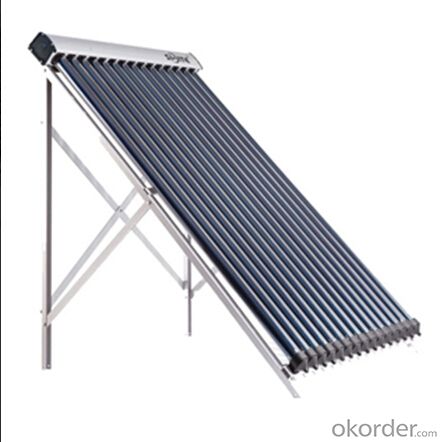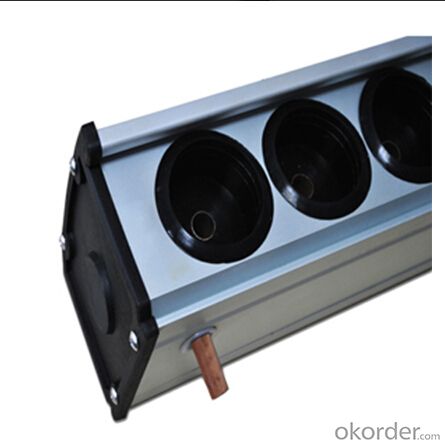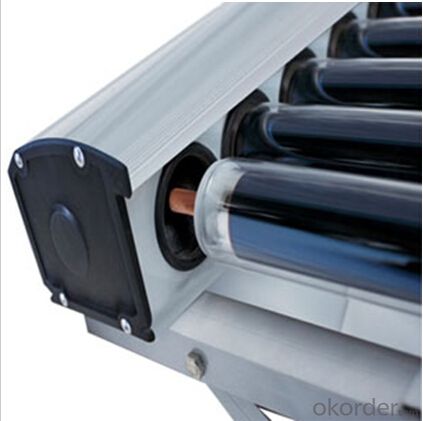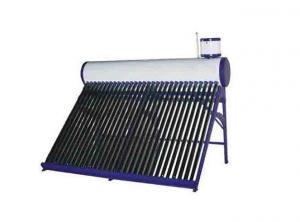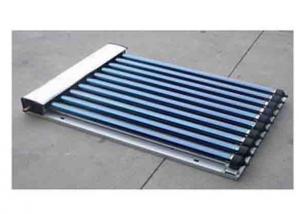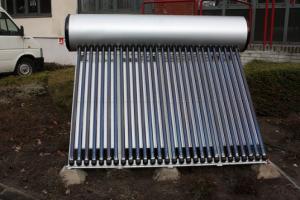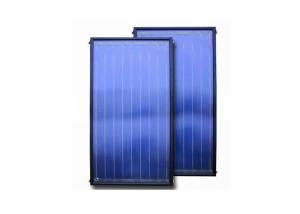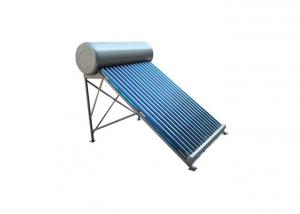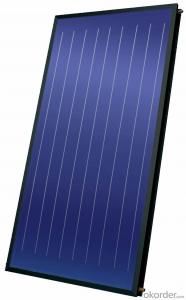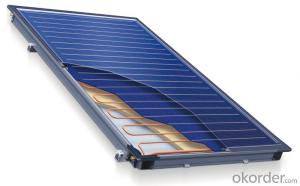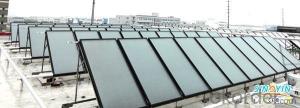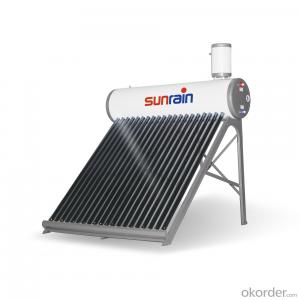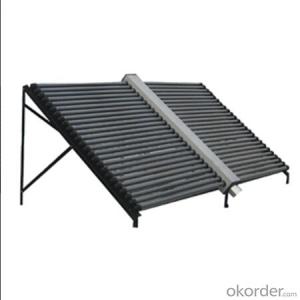Non Concentrating Solar Collectors - Inlet and Outlet at the Bottom of Manifold SC-HD
- Loading Port:
- Shanghai
- Payment Terms:
- TT OR LC
- Min Order Qty:
- 1 set
- Supply Capability:
- 2500 set/month
OKorder Service Pledge
OKorder Financial Service
You Might Also Like
1. Structure of Inlet and Outlet at the bottom of Manifold Solar Collector Model SC-HD Description:
This product is composed of Aluminium alloy for frame, rock wool for the insulation,tri-element vacuum glass tube and antifreeze heat pipe.It can often be used in subzero temperatures without the system sustaining damage. Flat plate systems often require expensive and complicated "antifreeze" systems to be installed.
2. Main Features of Inlet and Outlet at the bottom of Manifold Solar Collector Model SC-HD
1) The inlet and outlet be opened on the bottom of manifold; It looks more artistic than trandithional manifold;
2) Good sealed in end of cover, It can provide higher insulation efficiency;
3) The most advantage is that It can be Emptyed the medium( water or deicing fluid) in the Manifold;
3. Inlet and Outlet at the bottom of Manifold Solar Collector Model SC-HD Images
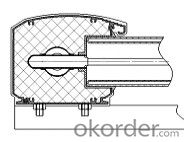
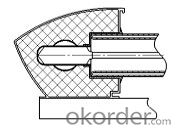
4. Inlet and Outlet at the bottom of Manifold Solar Collector Model SC-HD Specifications
Model | SC-HD-10 | SC-HD-15 | SC-HD-18 | SC-HD-20 | SC-HD-24 | SC-HD-25 | SC-HD-30 |
SC-H1-10 | SC-H1-15 | SC-H1-18 | SC-H1-20 | SC-H1-24 | SC-H1-25 | SC-H1-30 | |
Vacuum tube quantity(pcs) | 10 | 15 | 18 | 20 | 24 | 25 | 30 |
Tube spacing (㎜) | 75 | 75 | 75 | 75 | 75 | 75 | 75 |
Vacuum tube diameter/length (㎜) | φ58/1700 | φ58/1700 | φ58/1700 | φ58/1700 | φ58/1700 | φ58/1700 | φ58/1700 |
Vacuum tube material | high borosilicate glass 3.3 | high borosilicate glass 3.3 | high borosilicate glass 3.3 | high borosilicate glass 3.3 | high borosilicate glass 3.3 | high borosilicate glass 3.3 | high borosilicate glass 3.3 |
Vacuum tube inner/outer pipe wall thickness (㎜) | 1.6/1.8 | 1.6/1.8 | 1.6/1.8 | 1.6/1.8 | 1.6/1.8 | 1.6/1.8 | 1.6/1.8 |
Heat pipe condensing end diameter/length (㎜) | φ14/1750 | φ14/1750 | φ14/1750 | φ14/1750 | φ14/1750 | φ14/1750 | φ14/1750 |
heat pipe material/wall thickness (㎜) | Copper tp2/0.6 | Copper tp2/0.6 | Copper tp2/0.6 | Copper tp2/0.6 | Copper tp2/0.6 | Copper tp2/0.6 | Copper tp2/0.6 |
inner tank diameter/wall thickness (㎜) | φ35/1.0 | φ35/1.0 | φ35/1.0 | φ35/1.0 | φ35/1.0 | φ35/1.0 | φ35/1.0 |
connector size | φ22 or 3/4″ | φ22or 3/4″ | φ22or 3/4″ | φ22or 3/4″ | φ22or 3/4″ | φ22or 3/4″ | φ22or 3/4″ |
collector insulation material/thickness (㎜) | Rock wool/40 | Rock wool/40 | Rock wool/40 | Rock wool/40 | Rock wool/40 | Rock wool/40 | Rock wool/40 |
solar collector rated pressure (MPa) | 0.6 | 0.6 | 0.6 | 0.6 | 0.6 | 0.6 | 0.6 |
collector operating temperature ℃ | <100 | <100 | <100 | <100 | <100 | <100 | <100 |
collector volume (L) | 0.69 | 0.98 | 1.15 | 1.27 | 1.50 | 1.56 | 1.85 |
collector aperture area (㎡) | 1.0 | 1.5 | 1.8 | 2.0 | 2.4 | 2.5 | 3.0 |
collector total area (㎡) | 1.56 | 2.30 | 2.74 | 3.04 | 3.63 | 3.77 | 4.51 |
referral traffic (L/min) | 0.75 | 1.13 | 1.35 | 1.50 | 1.81 | 1.88 | 2.26 |
intensity pressure (Pa) | 23.2 | 59.2 | 90.6 | 116.7 | 181.7 | 200.2 | 314.0 |
intercept efficient η0 | 0.744 | 0.744 | 0.744 | 0.744 | 0.744 | 0.744 | 0.744 |
heat loss coefficient a | 2.09 | 2.09 | 2.09 | 2.09 | 2.09 | 2.09 | 2.09 |
collector power (W)1000W/㎡ irradiation | 620 | 870 | 1047 | 1165 | 1401 | 1457 | 1748 |
collector net weight (kg) | 38.25 | 50.75 | 59.75 | 64.75 | 79.00 | 83.35 | 98.70 |
a (㎜) | 895 | 1270 | 1495 | 1645 | 1945 | 2020 | 1395 |
b (㎜) | 800 | 1175 | 1400 | 1550 | 1850 | 1925 | 2300 |
c (㎜) | 725 | 1100 | 1325 | 1475 | 1775 | 1850 | 2225 |
c/2 (㎜) | —— | —— | —— | —— | 887.5 | 925 | 1112.5 |
d (㎜) | 1980 | 1980 | 1980 | 1980 | 1980 | 1980 | 1980 |
e (㎜) | 1240 | 1240 | 1240 | 1240 | 1240 | 1240 | 1240 |
f (㎜) | 1470 | 1470 | 1470 | 1470 | 1470 | 1470 | 1470 |
5. FAQ
(1) Which collector is the best value for money?
Rather than looking at just peak efficiency levels when comparing solar collectors, cost per unit of energy produced is much more logical. For example: Although collector A may be 20% more efficient than collector B, if collector A is 30% more expensive, then in fact collector B may be a better choice, as per kWh of energy produced per day it is cheaper. When payback time is of concern, not only price per kWh of the product is important, but also of the end system.
(2) Can this solar collectors be used for a large scale hot water production?
Yes. This solar collectors can be connected in series or parallel to provide large scale hot water production for a commercial settings such as a school, hotel or office building. There is really no limit to the size of the system, however collectors must be installed in banks of no more than 150 tubes (in series), otherwise the water may boil.
(3) What maintenance of the solar collector is required?
Under normal circumstances no maintenance of the system is required. Due to the shape of the tubes regular rainfall and wind should keep the tubes clean. Should a tube even be broken it should be replaced. This, however, is an inexpensive and easy job. Any "handy" person can install a new tube (while adhering to local health and safety regulations). Sidite solar collectors can operate with several broken tubes, however the efficiency will be reduced slightly.
- Q: Can solar collectors be used for heating air?
- Yes, solar collectors can be used for heating air. Solar thermal collectors, such as flat plate or evacuated tube collectors, can absorb solar radiation and convert it into thermal energy. This energy can then be used to heat air directly, either for space heating or for various industrial processes.
- Q: Can solar collectors be used in areas with limited access to educational resources?
- Yes, solar collectors can be used in areas with limited access to educational resources. Solar collector technology is relatively simple and can be easily understood and implemented with basic training. Additionally, there are numerous online resources and instructional materials available that can be accessed and utilized to educate communities on solar collector installation and maintenance.
- Q: Can solar collectors be used for cooling?
- Yes, solar collectors can be used for cooling through the process of solar cooling. Solar thermal collectors can generate heat, which can be harnessed to power absorption chillers or desiccant cooling systems, thus providing cooling. This process utilizes renewable energy from the sun to provide cooling solutions, making it an environmentally friendly option.
- Q: Can solar collectors be used for heating aquariums?
- Yes, solar collectors can be used for heating aquariums. Solar collectors harness the energy from the sun and convert it into heat, which can be used to warm water in aquariums. This can provide a cost-effective and environmentally friendly way to maintain optimal water temperature for the aquatic organisms.
- Q: Can solar collectors be used to heat swimming pools?
- Yes, solar collectors can be used to heat swimming pools. They absorb the sun's energy and transfer it to the pool water, increasing its temperature. This is an energy-efficient and cost-effective way to heat pools, reducing the reliance on traditional heating methods.
- Q: What is the impact of wind on the performance of solar collectors?
- The impact of wind on the performance of solar collectors can be both positive and negative. On one hand, wind can help to cool down the solar collectors and prevent them from overheating, which can improve their overall efficiency. On the other hand, strong winds can create turbulence and increase heat losses from the collectors, reducing their effectiveness. Therefore, it is important to consider the local wind conditions and design the solar collector system accordingly to optimize its performance.
- Q: Are solar collectors suitable for restaurants and cafes?
- Yes, solar collectors are suitable for restaurants and cafes as they can provide a sustainable and cost-effective solution for heating water and generating electricity, reducing energy expenses and carbon footprint. Additionally, they can be installed on rooftops or outdoor spaces, making them adaptable to the limited space often found in urban areas.
- Q: Do solar collectors require batteries for energy storage?
- No, solar collectors do not require batteries for energy storage. The energy generated by solar collectors can be directly used or fed into the electrical grid without the need for batteries. However, batteries can be used for energy storage in cases where solar power needs to be stored for later use, such as during nighttime or cloudy days.
- Q: Can solar collectors be used in areas with limited access to financing options?
- Yes, solar collectors can be used in areas with limited access to financing options. There are various financing models available that can make solar energy affordable, such as leasing, power purchase agreements, and community solar programs. Additionally, governments and non-profit organizations often provide grants and subsidies to support the adoption of solar energy in underserved areas, further increasing accessibility.
- Q: Can solar collectors be used in recreational facilities?
- Yes, solar collectors can be used in recreational facilities. They can be installed to harness solar energy and provide heating or hot water for pools, spas, or other recreational amenities. This eco-friendly solution can help reduce energy costs and contribute to a more sustainable operation of the facility.
Send your message to us
Non Concentrating Solar Collectors - Inlet and Outlet at the Bottom of Manifold SC-HD
- Loading Port:
- Shanghai
- Payment Terms:
- TT OR LC
- Min Order Qty:
- 1 set
- Supply Capability:
- 2500 set/month
OKorder Service Pledge
OKorder Financial Service
Similar products
Hot products
Hot Searches
Related keywords
